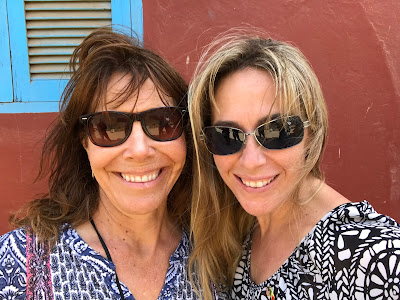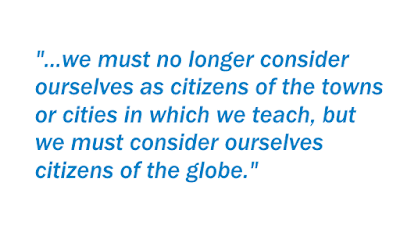Saturday morning we left Nioro du Rip at 8am to head back to Dakar and meet up with the rest of the team. We said our farewells and words of gratitude to our host teacher, Papa Amadou Seck before making the 4-hour drive to Dakar. Nan and I definitely had an unforgettable experience in Nioro. We learned to let go and do without a lot of the comforts we are used to. We learned about the education system of Senegal, in addition to Senegalese culture. We also learned to never take certain things for granted. So, for my last Senegal blog post here are two lists we made as a reflection on both:
Things We Are Grateful For:
1. Our partnership: Nan and I got along immediately when we met each other in Washington DC. We are so lucky and blessed that we were paired up together. We had more belly laughs than I ever remember having. I know that Nan will always be a close friend - and I have TGC to thank for that.
2. Our host teacher, Papa, and our host school: Papa did so much for us when we were in Nioro. He worked so hard to ensure that Nan and I were well taken care of, and had the best experiences. He also was quick to answer the many questions we had about life in Nioro.
3. Buckets of water: Yep. Buckets. We needed them and used them daily. We actually came to depend on them to collect water to save in case ours went out.
4. Nose Hairs: they serve a purpose.
5. Fanta/Sprite: It was so hot on some days - we would try and find water in little stands, but it was often not refrigerated. We could almost always count on cold Fanta or Sprite... which tasted amazing on a hot day.
6. Nescafe: We had instant Nescafe coffee every morning (and sometimes at lunch) - much-needed caffeine.
7. Toilet Paper: Pretty self-explanatory. Good thing we each grabbed a roll from the hotel we stayed at in Dakar.
8. Malaria Pills/Vaccinations: I was eaten alive by mosquitos in Dakar (not Nioro). I must have had at least a dozen bites. I am so thankful for the meds I was taking. Thankfully, I didn't get sick once when I was in Senegal.
9. Days we had a flushing toilet. Yep. Sometimes it did - and sometimes it didn't.
10. Waking up to running water in the morning - best sound ever!
11. Wifi: Wifi really helped me feel and stay connected with family and friends back home.
12. Google Translate: I used this A LOT! I used it in museums and in conversation with people in Senegal since I don't speak French! It was amazing - and came in VERY handy.
13. Smiles and kindness: Despite language barriers, smiles and kindness always go a long way. We once saw a man outside our hotel sitting on the steps with a bowl of rice and fish. We had never seen him before, and he had never seen us, I presume. He was quick to say "Come! Have a seat! Eat with me!"
14. Education: I am so thankful for education. I am thankful for our education system in the US and for the Senegalese education system willing to host the US teachers. I am grateful we live in a global society and are able to learn from one another and make connections around the world.
15. My School District: I am so thankful for the support, love, concern and enthusiasm from my school district. Without it, this trip wouldn't have been possible. I am so thankful for the many texts, emails, notes, gifts and words of support from the many people I work with. It's an incredible feeling to feel loved and supported in your profession.
Things We Will Never Take For Granted:
1. Toilets. Real toilets. Everything about toilets, especially when they flush and have seats. Nan went an entire week without a toilet seat! LOL
2. Running water/potable water. Water is GOLD. We need to do everything in our power to conserve this precious resource.
3. Shower curtains: Nan and I went a week without a shower curtain. It's definitely a strange feeling and makes quite the watery mess on the bathroom tile floor.
4. Hair dryers: I blew mine up the first day I was in Senegal.
5. Towels: The first day I was in Nioro I had to make a run to the market to see if they had towels. IN retrospect, I should have packed a towel and a washcloth - not just wipes.
6. Sheets: Although we had fitted sheets, we didn't have a top sheet or a blanket. I hope I'm not alone in feeling "safer" and more "secure" with a blanket on... even if it's 100 degrees outside, I still prefer a blanket or sheet. Probably should add good pillows to this list, too.
7. Lighting: Good lighting. Lightning that really goes on and stays on, and is bright. Add to this list - power/electricity in general. When the power goes out, so does everything else - including wifi and fans. It gets hot super quick and is stifling.
8. Outlets: Outlets were definitely sparse... we had one in our entire room and bathroom in Nioro.
9. Beds that don’t break when you roll over: Yep. Just ask Nan about this one.
10. Garbage cans/sanitation: Garbage cans were few and far between. I am so thankful that we have a system for garbage and recycling. The environment is another precious resource that we need to take care of...
11. Fans/AC: Much needed in 104+ weather
12. Refrigeration: Most people/places do not have refrigeration. I have always just taken for granted that I can get up and go to my fridge anytime I need/want. That isn't the case with many people. We can save food, keep drinks cold. It's a luxury and a blessing.
13. Shoes: Walking in hot sand can be brutal on feet - and I was so glad to have shoes that fit well. It was sad to see lots of children barefoot or with shoes that were too small on their little feet. I can only imagine how hot the sand must have been.
14. Women's rights: Women's agency and power is a vital part of our society... and for that I am grateful. #GirlPower #LikeAGirl
15. Fruits and veggies: I will never take for granted the ample choices we have of fresh fruits and veggies available to us (especially here in California).
16. Abundance and choice: There were many things that had an impact on me when I was in Senegal, and will forever change me. Two words that stick out to me are ABUNDANCE and CHOICE. I will never ever take for granted the vast amount of choices we have in the United States. Do you want to go to Starbucks or Coffee Bean? Do you want to eat fast food or sit down? Do you want Italian food or Mexican? Do you want to drive or take a bus/taxi/uber? We don't realize the number of choices we make on a daily basis. Not everyone has the luxury of making so many choices. We are spoiled in the amount of extreme customization we make with foods and drinks (I'm definitely guilty of this myself). When you have no choices for food or drinks and are hungry and thirsty - you are grateful for anything. The same goes with the word "abundance." We have so much excess here in the States. We often think we have "no resources" or "not enough." Trust me when I say, we have enough. We have plenty. We probably have TOO much. We have so much to be thankful for, and so little to complain about. We have abundance and choice.
I am eternally grateful for the experiences I had in Senegal, specifically in Nioro. I am grateful for the amazing friend I have found in my partner, Nan, and for the friendships I have made with educators around the globe in Senegal. I hope these connections and relationships last and continue to grow. I am working on setting up some kind of partnership project with an elementary school in Nioro and with the town library. I will definitely be posting about that as it develops. For now, thank you to everyone who checked my photos on Facebook, sent texts of encouragement, and took the time to read this blog. Thank you for coming along with me on my journey to Senegal. It's only the beginning of wonderful things to come.
I am eternally grateful for the experiences I had in Senegal, specifically in Nioro. I am grateful for the amazing friend I have found in my partner, Nan, and for the friendships I have made with educators around the globe in Senegal. I hope these connections and relationships last and continue to grow. I am working on setting up some kind of partnership project with an elementary school in Nioro and with the town library. I will definitely be posting about that as it develops. For now, thank you to everyone who checked my photos on Facebook, sent texts of encouragement, and took the time to read this blog. Thank you for coming along with me on my journey to Senegal. It's only the beginning of wonderful things to come.


















































